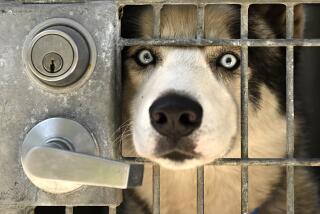INTERIORS : Stylish Home Is a Pet Project
- Share via
Can a home with pets be as attractive as one with no barks or purrs?
“Yes,” Jane Victor says.
“Of course,” Lovejoy Duryea says.
For these decorators--and many of their clients--a house isn’t a home without a pet. Yet each has high standards for ambience and housekeeping.
Mostly it’s a matter of knowing what not to have, says Duryea, chairwoman of the interior design department at the School of Visual Arts in New York and a breeder of Norfolk terriers. She wouldn’t use shiny lacquer furniture or glass tables or nubby textiles that cats, especially, will claw and knead into unsightliness. Instead, she’d choose tightly woven fabrics and low-gloss surfaces of wood, stone, ceramic or synthetics.
No-no fabrics for families with felines include Haitian cotton, raw silk, brocade, hand-woven textiles and leather. Cats also get their claws into looped carpets such as Berber and needlepoint. So opt for smooth fabrics such as chintz, tight woven cottons and cotton-polyester blends and cut pile rugs.
Victor, chairman of the New York chapter of the American Society of Interior Designers, says a well-trained pet helps make for a well-maintained home. Because dogs and cats are creatures of habit, they seldom stray from places set aside for sleeping, eating and playing, she says.
At her home, Victor installed a pet entrance in an unused fireplace in the dining room. To teach her two dogs and a cat to use the low swinging door, she crawled through the opening then called for them to follow.
“They figured it out instantly,” she says.
The fireplace, with its original decorative mantel, offers convenient, unobtrusive access to indoors and outside. The door can be locked, and the pets make sure no other animals, wild or otherwise, cross the threshold.
Even the best-trained pets aren’t perfect. As insurance against dog urine stains on the rug, Duryea suggests keeping an enzyme cleaner such as Nature’s Miracle on hand. Follow instructions, and it should lift out any stain.
No matter how fastidious your cat--or how diligent your housekeeping--litter boxes are equated with odor. Where possible, Victor advocates hiding them, usually in a little-used bathroom. One suggestion is behind a swinging door in the vanity beneath the sink.
Most cats are inherently graceful, but there’s no reason to risk breakable objects. Duryea advises weighting delicate vases by putting small stones in a muslin bag inside them.
Rather than a carpeted scratching post from the pet shop--”They teach the cat to claw something you don’t want them to claw”--she advocates a log, such as white birch, with the bark still intact. The bark should help keep the cat happy and the claws short.
There are ways to discourage cats from jumping onto the furniture. For a favorite table, stretch a piece of Contact paper, sticky side up, over a piece of cardboard. Tape the board to the tabletop with drafting tape, which won’t leave marks when it is removed. A few forays into sticky territory are likely to deter all but the most stubborn cat. Put inflated balloons on upholstered pieces you want to make off-limits. One or two loud pops should send the message.
In the Duryea household, the living and dining rooms are off-limits to the dogs. Now well-trained, they make no attempt to enter. In the past, they were barred by a piece of garden trellis. For large dogs, she recommends hanging a decorative iron gate.
For clients who want their pets to have the run of the house, Duryea suggests washable slipcovers with sleeves over upholstery. Victor recommends shades or valances rather than long draperies.
For future pet owners who want a presentable home, Duryea’s advice is to consider your furnishings and available time:
“We have Norfolk terriers, which are small dogs that can be exercised minimally and need to be combed only once or twice a week. Sheep dogs, by contrast, can require up to an hour’s worth of grooming every day.”


